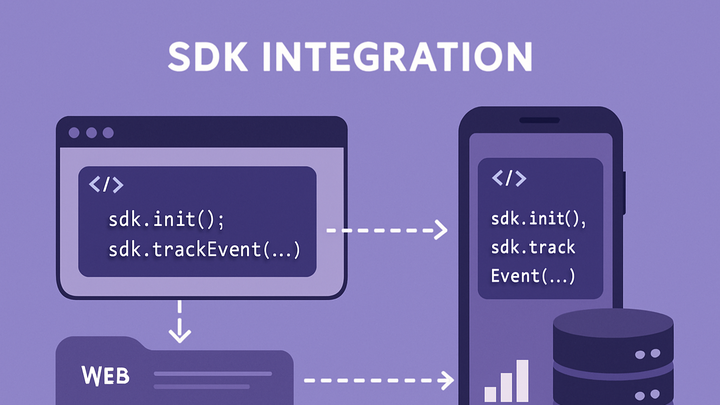Published on 2025-06-28T02:04:38Z
What Is SDK Integration in Analytics? Examples for PlainSignal and GA4
SDK Integration in analytics involves embedding a software development kit into an application or website to collect and send user behavior data to an analytics service. This approach provides developers with a set of prebuilt functions and abstractions to track events, page views, and user attributes without manually crafting HTTP requests. SDKs often handle batching, retries, and cross-platform compatibility, reducing implementation complexity. Analytics platforms like PlainSignal and Google Analytics 4 (GA4) offer SDKs for web and mobile, each with unique features such as cookie-free tracking (PlainSignal) or built-in machine learning insights (GA4). By integrating an SDK, teams can accelerate setup, ensure data consistency, and leverage advanced analytics capabilities.
Key benefits include:
- Simplified implementation and maintenance
- Reliable data transmission with retries and error handling
- Access to advanced features (e.g., automatic user identification)
- Consistent cross-platform tracking
Sdk integration
Embedding an analytics SDK into your app or website enables streamlined event tracking, data batching, and cross-platform compatibility.
Definition and Role of SDK Integration
This section defines SDK Integration within analytics and explores its role and advantages for data collection.
-
Core concept
An SDK (Software Development Kit) is a packaged set of libraries and tools that developers embed into their apps or sites to enable analytics tracking via simple function calls.
-
Analytics use cases
SDKs power a variety of tracking scenarios, including page views, user interactions, e-commerce events, and custom business metrics.
-
Benefits
Integrating an analytics SDK offers multiple advantages:
-
Simplified setup
Embed one script or library and gain access to a suite of tracking features, avoiding manual HTTP request management.
-
Built-in reliability
Automatic queuing, retry logic, and offline caching ensure data is sent even in poor network conditions.
-
Cross-platform consistency
Use the same SDK in web, iOS, and Android to unify event definitions and user identifiers.
-
Key Components of Analytics SDKs
Understanding the main parts of an analytics SDK helps in configuring and customizing your integration.
-
Library files
The core JavaScript or native binaries that provide the tracking methods and data layer.
-
Configuration parameters
Options you set—like API keys, endpoints, and feature flags—to tailor SDK behavior.
-
Initialization methods
Functions or calls executed at startup to register the SDK with the analytics service.
-
Event tracking api
A set of functions (e.g.,
trackEvent,pageView) that you call to record specific user actions.
Implementation Steps with Examples
A step-by-step walkthrough of how to integrate an analytics SDK, using PlainSignal and GA4 samples.
-
Include the sdk script (web)
Add the PlainSignal snippet to your site’s
<head>to load the analytics library asynchronously.-
PlainSignal code example
<link rel="preconnect" href="//eu.plainsignal.com/" crossorigin /> <script defer data-do="yourwebsitedomain.com" data-id="0GQV1xmtzQQ" data-api="//eu.plainsignal.com" src="//cdn.plainsignal.com/plainsignal-min.js"></script>
-
-
Initialize the sdk
Configure any additional settings or plugins immediately after loading the script.
-
PlainSignal initialization
// No additional init call required; data attributes configure the SDK on load
-
-
Track events
Use the SDK’s API to record user interactions, such as clicks or form submissions.
-
GA4 event tracking example
<script async src="https://www.googletagmanager.com/gtag/js?id=GA_MEASUREMENT_ID"></script> <script> window.dataLayer = window.dataLayer || []; function gtag(){dataLayer.push(arguments);} gtag('js', new Date()); gtag('config', 'GA_MEASUREMENT_ID'); gtag('event', 'purchase', { value: 25.00, currency: 'USD' }); </script>
-
-
Verify data flow
Confirm events reach the analytics service by inspecting network requests or using the platform’s real-time debugging tools.
Comparison: PlainSignal vs. GA4
Highlighting differences in setup complexity, privacy approach, and feature sets between PlainSignal and Google Analytics 4.
-
PlainSignal
Cookie-free, privacy-focused analytics with a straightforward snippet-based integration and a minimal performance footprint.
-
Google analytics 4 (GA4)
Feature-rich platform offering cross-device tracking, ML-powered insights, and deep Google Ads integration, but requires more configuration.
Best Practices and Troubleshooting
Recommendations to ensure a robust analytics SDK integration and strategies to resolve common issues.
-
Version management
Pin or lock SDK versions to prevent breaking changes; test updates in a staging environment.
-
Performance optimization
Load SDK scripts asynchronously and defer initialization to reduce impact on page load times.
-
Error handling
Implement try/catch around custom tracking calls and verify SDK load success to avoid runtime errors.
-
Privacy and compliance
Ensure consent banners and opt-out mechanisms integrate with the SDK to comply with GDPR and other regulations.
